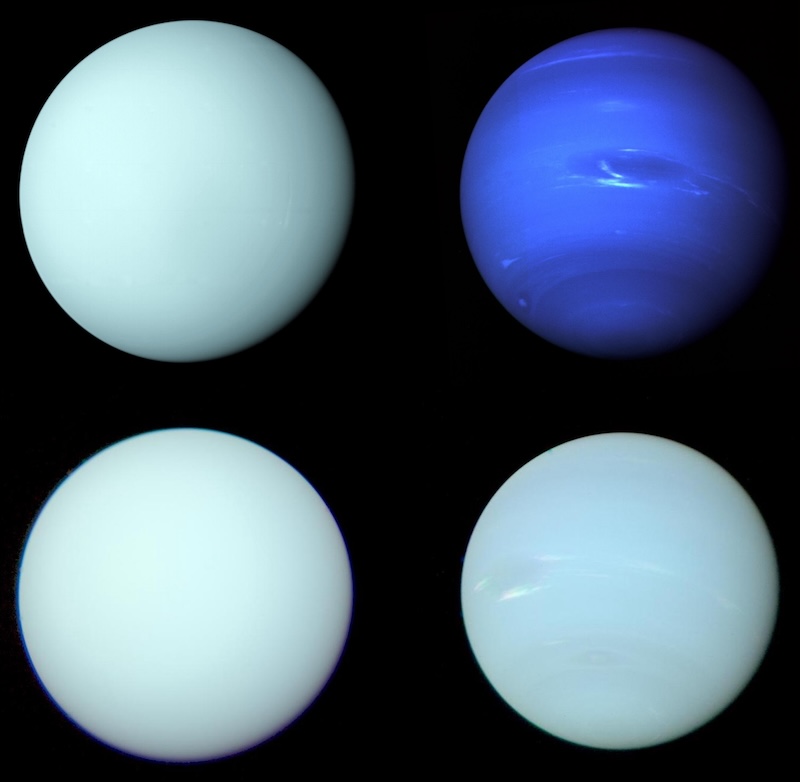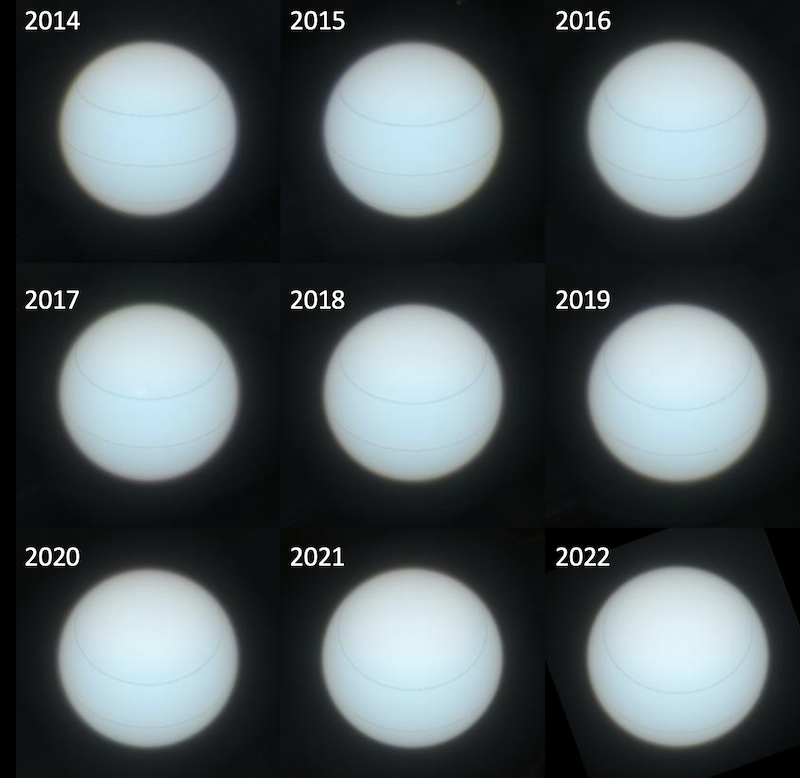
we see it as a light greenish-blue, almost the same as Uranus. Image via Patrick Wilson/ University of Oxford.
We’ve all seen photos of the two ice giants in our solar system, Uranus and Neptune. These photos generally show Uranus as a light greenish-blue, while Neptune is a much darker blue. But it seems that this portrayal isn’t accurate. On January 4, 2024, researchers at the University of Oxford in the U.K. said that a new study has revealed the true colors of these distant worlds. As it turns out, they’re nearly the same color.
The research team published their peer-reviewed results in the Monthly Notices of the Royal Astronomical Society on January 5, 2024.
The 2024 lunar calendars are here! Best New Year’s gifts in the universe! Check ’em out here.
Early Voyager 2 images of Uranus and Neptune
Back in 1986 and 1989, NASA’s Voyager 2 spacecraft flew past Uranus and Neptune, respectively. Those images showed the two planets looking significantly different. Uranus was a light greenish-blue, while Neptune was a much darker azure blue. Originally, Voyager 2 took the images in single separate colors. Later, scientists on Earth combined them to create color composites. They were not always accurately color-balanced, however. This resulted in Neptune having a deeper shade of blue than it actually does. Neptune was too blue, you could say.
Also, for the Neptune images, the scientists strongly enhanced the contrast. They did that so they could more easily see the clouds and banded atmosphere, which Uranus generally lacks.
Patrick Irwin from the University of Oxford led the new study about Uranus’ and Neptune’s colors. He stated:
Although the familiar Voyager 2 images of Uranus were published in a form closer to ‘true’ color, those of Neptune were, in fact, stretched and enhanced, and therefore made artificially too blue. Even though the artificially saturated color was known at the time among planetary scientists – and the images were released with captions explaining it – that distinction had become lost over time. Applying our model to the original data, we have been able to reconstitute the most accurate representation yet of the color of both Neptune and Uranus.
The deep blue version of Neptune became the one that the public and media saw most of the time and became familiar with.
Colors of Uranus and Neptune more alike than thought
But now, the researchers at the University of Oxford have corrected this faulty color view of Neptune. To do so, they used data from the Hubble Space Telescope’s Space Telescope Imaging Spectrograph (STIS) and the Multi Unit Spectroscopic Explorer (MUSE) on the European Southern Observatory’s Very Large Telescope (VLT). Instead of showing single colors like Voyager, each pixel in both instruments shows a continuous spectrum of colors. This allows scientists to process the images in true color.
They re-balanced both the old images from Voyager 2 and newer ones from Hubble’s Wide Field Camera 3 (WFC3). The result? Uranus and Neptune are actually closer in color than previously thought. Neptune is no longer a deep azure blue. Rather, it is a much lighter greenish-blue, quite similar to Uranus. It is still slightly more blue than Uranus, but not by a lot. The paper says:
Finally, we find that although the visible color of Uranus is less blue than Neptune, due to the increased aerosol thickness on Uranus, and this difference is greatest at Uranus’s solstices, it is much less significant than is commonly believed due to a long-standing misperception of Neptune’s ‘true’ color.
Still different in other ways though
Uranus and Neptune are also almost the same size, and both have deep hydrogen and helium atmospheres surrounding a rocky core. However, we do know that Uranus and Neptune are still distinctly different in other ways. Neptune has darker bands in its atmosphere, like Jupiter and Saturn, while Uranus is more bland. Also, unlike Neptune and Earth and most other major planets in our solar system, Uranus doesn’t rotate around an axis that lies nearly perpendicular to the plane of its orbit. Instead, its axis is tilted 97 degrees, so the planet basically rotates on its side.
In addition, the larger moons of Uranus are in stable orbits that are aligned with the tilt of the planet. But Neptune’s largest moon, Triton, circles the planet at a very inclined orbit. These differences seem to suggest that Uranus’ moons formed from the same disk of dust and gas that the planet itself did, while Triton was probably once a separate object captured by Neptune’s gravity.
This animation shows seasonal changes in color on Uranus during 2 Uranus years (1 Uranus year is 84.02 Earth years), running from 1900 to 2068 and starting just before southern summer solstice. That is when Uranus’ south pole points almost directly toward the sun. The left-hand disk shows how Uranus appears to the unaided eye, while the right-hand disk has been color stretched and enhanced to make atmospheric features clearer. Video via Patrick Irwin/ University of Oxford/ EurekAlert!.
Color changes on Uranus
The new imaging results not only showed that Uranus and Neptune are quite close in natural color, they also helped answer another question: why does Uranus change color slightly as it orbits the sun? The Lowell Observatory in Arizona observed Uranus from 1950 to 2016 at blue and green wavelengths. When the researchers compared the measurements of the brightness of Uranus to the images, they noticed something. Uranus displayed a slightly different color between its solstices and equinoxes. It appeared a little greener during the solstices. That’s when one pole of the planet is pointing toward the sun. But during the equinoxes, as the equator of Uranus is facing the sun, it looked slightly bluer.
Uranus’ weird axis spin is partly to blame. As noted above, it rotates almost completely on its side. Therefore, during its solstices, the poles will point almost directly at the sun. The resulting brightness changes at the poles of the planet could affect its overall brightness as seen from Earth. But why the difference in color?
The researchers found that Uranus’ polar regions are more reflective in green and red wavelengths of light. They are not as good at reflecting blue. The reason is that methane absorbs red wavelengths, but it’s only half as abundant at the planet’s poles than at its equator. That still wasn’t the complete answer, however.

Uranus’ icy methane haze
A “hood” of icy haze also plays a role. The haze, which scientists think is composed of methane ice particles, gradually thickens over the sunlit pole in the summer. When the researchers did computer modeling of the haze, they found that it increased the reflection of green and red wavelengths even more. This, along with the other regular reflectivity, is enough to explain the color changes. As Irwin noted:
This is the first study to match a quantitative model to imaging data to explain why the color of Uranus changes during its orbit. In this way, we have demonstrated that Uranus is greener at the solstice due to the polar regions having reduced methane abundance but also an increased thickness of brightly scattering methane ice particles.
Heidi Hammel, of the Association of Universities for Research in Astronomy (AURA), added:
The misperception of Neptune’s color, as well as the unusual color changes of Uranus, have bedeviled us for decades. This comprehensive study should finally put both issues to rest.
Bottom line: Researchers at the University of Oxford in the U.K. have determined the true colors of Uranus and Neptune. They are much more similar than previously thought.
Source: Modelling the seasonal cycle of Uranus’s colour and magnitude, and comparison with Neptune











